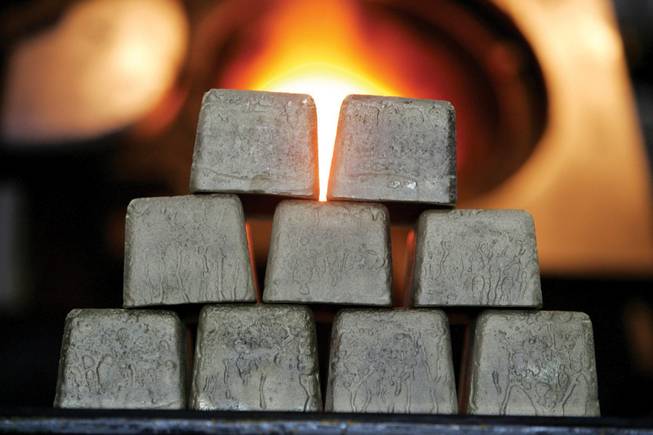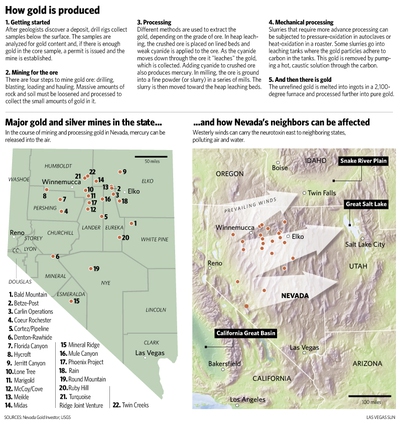
NEW YORK TIMES FILE
Nevada, the Silver State, is also a major producer of gold, which is selling for around $1,600 per ounce in March 2013.
Tuesday, April 21, 2009 | 2 a.m.
Enlargeable graphic
Jerritt Canyon
Sun Archives
- Regulators OK restart of Nevada mine (3-25-09)
- EPA allegations spark call for checks on state's mines (1-27-2009)
- Heavy price for gold (3-5-2006)
- No new laws seen for mines (3-5-2006)
- Nevada mines release most mercury (6-28-2004)
Sun Blogs
Beyond the Sun
Nevada’s Jerritt Canyon gold mine, shuttered last year for failing to curtail emissions of airborne mercury, reopened recently and began pouring gold that will sell at today’s historically high prices of about $800 an ounce.
A decade ago, the mine 50 miles north of Elko was sending as much mercury into the air as dozens of coal-fired power plants. Now it is under strict state orders to keep pollution to a minimum.
By all appearances, the state has solved a problem, right?
Not so fast.
What happened at Jerritt Canyon can be seen through a different lens.
Yes, it can be taken as a sign that Nevada’s emerging mercury emission control program, the first of its kind in the nation, is working.
Conversely, it can be seen as a reason the federal Environmental Protection Agency needs to begin regulating mercury emissions from gold mines nationwide — because state regulation wasn’t enough.
The EPA will decide this summer whether it needs to intervene in regulating gold mines. Certainly the Obama administration has signaled its concern, taking steps to combat mercury emissions at home and globally, reversing Bush administration policies in the process.
But the EPA’s interest in Nevada did not begin with President Barack Obama. Instead, the EPA is acting under a court order issued in the fall in a long-running lawsuit over clean-air standards. The agency will consider regulations specifically on gold mines — a first for an industry that has deftly avoided government intervention for much of its history.
If the EPA decides to regulate mercury emissions from mining, the Nevada experience would stand as either a model to be exported to other gold mining states, or one that stands in need of improvement.
“The Nevada program will be put to the test,” said Justin Hayes, who has long monitored Nevada’s gold mining industry as program director of the Idaho Conservation League. “Now there is the question whether EPA will use the Nevada program as a launching pad or whether they’ll scrap it,” Hayes said.
“If the Nevada program stands up to that scrutiny, great,” he said. “If it crumbles, I’m confident under this administration it will promulgate rules that are much more effective.”
Mercury is released into the air in many ways during the gold mining process — even simply by crushing the rock itself to get at the ore. Mercury is also emitted from smokestacks as part of the industrial operation of modern gold mining.
Children, pregnant women and fetuses are especially susceptible to neurological damage and are cautioned against consuming mercury-contaminated fish.
But gold mining has had enough clout to essentially avoid any federal cap on mercury emissions. Only in 1998 did the EPA, under President Bill Clinton, begin requiring gold mines to report their mercury emissions. Once the early reports were released in 2000, the flow of airborne mercury became clear. Nevada’s No. 2 industry accounted for most of the mercury emissions in the nation. Jerritt topped the list of four gold mines in the state that contributed 90 percent of the emissions from Nevada.
The EPA considered federal standards at the time, but declined, noting that putting them in place could take five years. Also, the state offered to put its own volunteer program in place quickly. So the EPA, with the blessing of some environmentalists, including a founding member of a Great Basin Mine Watch, agreed to let the state take the lead.
Under the state program, the four large mines agreed to a voluntary reduction program in 2002. It purportedly showed quick and strong results. Mercury emissions were slashed more than 80 percent over the next few years, according to the Nevada Environmental Protection Department.
Jerritt, in particular, showed sharp reductions, according to data filed with the EPA.
The Bush administration’s EPA heralded the Nevada program’s “extraordinary reductions.”
The state decided in 2005 to expand the program to a mandatory one, covering all of Nevada’s gold mines the following year.
But Hayes, the Idaho environmentalist, was skeptical. He wanted to see for himself the mercury levels coming from his southern neighbor. Idaho, Utah and other intermountain Western states had been concerned for years about rising levels of mercury in fish and fowl. Mercury blowing from Nevada’s mines has been seen as a culprit.
So Hayes picked up an off-the-shelf detection device, drove over the border and began documenting readings from outside the mines. He registered high levels of mercury.
In 2007, Hayes and environmental groups trumpeted new emissions data they were discovering. They also cited a draft report he obtained of the state’s monitoring program for the previous year that showed Jerritt’s reductions were not what they had been claimed to be.
The state contended the draft was invalid. But Great Basin Mine Watch threatened legal action.
“That was the beginning of the end of Jerritt Canyon,” Hayes said.
The integrity of Nevada’s first-ever monitoring program, which had been expanded to all gold mines in the state, had been challenged by a question: Would the state have stepped in to shutter Jerritt without the bad PR being generated by the activists?
The state’s deputy administrator of the Environmental Protection Division, Colleen Cripps, calls the above version of events “environmental lore.”
“Coincidentally, that may have happened, but it had nothing to do with what we did with Jerritt,” Cripps said.
Jerritt’s CEO at Queenstake Resources declined an interview with the Sun, on the advice of lawyers, a spokeswoman for parent company Yukon-Nevada Gold Corp. said by e-mail.
The state’s version of what happened is this: After the voluntary program showed promising results, the state in 2005 turned it into a mandatory program covering all gold mines. Then two years later, state investigators discovered mercury and other problems at Jerritt during routine inspections. They demanded the mine make improvements, a step supporters of the state program say shows that it is working.
The company failed to comply so the state shuttered Jerritt in March 2008. The mine reopened a month later on condition that it make several improvements by year’s end, including controls on mercury. But by August, the mine voluntarily shut down.
Jill LeFrano, a spokeswoman for the Nevada Environmental Protection Division, said “Jerritt Canyon Mine is a good example of how Nevada is working successfully with the mining industry to reduce mercury emissions.”
LeFrano said the mine, which once sent more than four tons of mercury a year into the air, was allowed to reopen last month on the condition that by May it install devices to reduce emissions. The state believes no more than 175 pounds will escape annually.
“Workers are back on the job and the local economy will benefit,” LeFrano said.
Environmentalists appreciate the state’s efforts but are wary. Glenn Miller, a natural sciences professor at the University of Nevada, Reno, and founding board member of Great Basin Mine Watch (which has since changed its name to Great Basin Resource Watch), was among those who agreed to let the state take the lead in overseeing mercury emissions earlier in the decade.
“It was a bad decision,” Miller said last week. The five-year EPA rule-making timetable “would have been up in 2005,” he said. “That would have been a lot more than what we have now.”
As EPA turns its attention to gold mining today, Nevada officials worry federal intervention would disrupt their program.
The next phase of the state program is to require each mine to install by 2011 the best technology available to prevent mercury emissions. Some companies have already done so.
Any program the EPA puts in place may look similar to Nevada’s. Or more likely it would require a numerical cap on emissions, said Jim Pew, the lead attorney from the environmental law firm Earthjustice, which represents the Sierra Club in the long-running lawsuit against the EPA.
“You want something people can verify,” Pew said. “Are these companies complying with their requirements or not?”
The state attorney general’s office hopes to block the EPA from proposing regulations, arguing in court papers that a federal program would cast a “significant cloud” over the future of the Nevada effort. The Nevada Mining Association also promises to fight the EPA, even as mining giant Newmont is working with the EPA to devise what the company called a “workable” regulation.
Bill Frey, a senior deputy attorney general in Nevada, argues the state’s program was done with federal blessing and now, “a little bit, we feel like we’re being double crossed by EPA.”
Since reopening last month, Jerritt Canyon has been ramping up its production capacity.
The company lost $105 million last year because of the shutdown, according to a release to investors. But it noted that it has 80,000 ounces of gold on site waiting to be milled. It also hopes to restart mining operations. At a production cost of less than $300 an ounce, the company expects once the onsite gold is milled it will “be able to deal with all of its outstanding liabilities.”
That is expected to happen by year’s end.


Join the Discussion:
Check this out for a full explanation of our conversion to the LiveFyre commenting system and instructions on how to sign up for an account.
Full comments policy